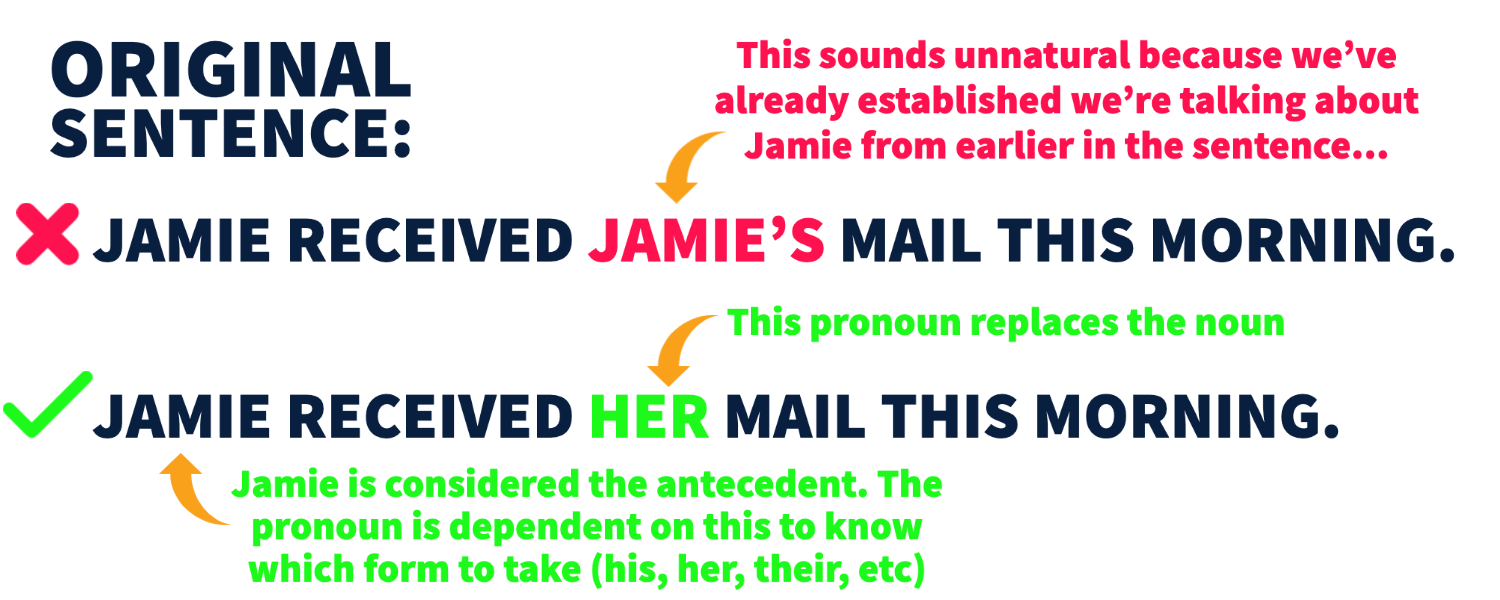Explanation
Pronouns take the place of a noun. Specifically, a pronoun replaces a noun called an antecedent. Moreover, a pronoun-antecedent agreement requires that the pronoun agrees in gender and number to the antecedent it replaces. This can all sound frustratingly confusing, so let’s break it down step by step:

The antecedent (the word is Latin for ‘going before’) is the noun that a pronoun relies on to agree in gender and number. If the noun is Jamie, we can assume the gender to be female (though we may need to rely on further information) and the number to be singular (there is only one person). Therefore, the pronoun following the antecedent (Jamie) is her in the example above.
Writers use a variety of different pronoun types to avoid repeating the noun to improve the text’s flow. Below is a table of pronoun examples:
| Subject Pronoun | I, we, you, he, she, they, it | You are a great leader. They went to the store. |
| Object Pronoun | me, us, you, him, her, them, it | Jim made us cut the lawn. I helped them study. |
| Possessive Pronoun | my, mine, our(s), your(s), his, her(s), their(s), its | The shop has great prices for its products. Is this pencil his or mine? |
- Subject pronouns take the place of the subject of a sentence
- Object pronouns take the place of an object of a sentence
- Possessive pronouns show possession
Object pronouns can be particularly confusing, but they simply are the objects that catch a verb. Since we already know what the object is from a prior sentence, we utilize an object pronoun to avoid repetition. Below is an example:
Tim and Barry went outside. Jim, their physical instructor, made them run laps.
Since there’s more than one person who went outside and had Jim as a physical instructor, we use their (possessive pronoun since Jim is their instructor). Similarly, we use them to relay that both Tim and Barry were made (the verb that them is catching) to run laps.
Questions:
The following question segment is pertains to the following GED Reading and Language Arts skill:
- Applying Knowledge of English Language Conventions and Usage
- Edit to correct errors in pronoun usage at a satisfactory level
For the following questions, replace the bold nouns with their respective pronouns.
- After Jake and I ran laps, Jake and I went home.
- Bob and Jenny used Jenny’s car.
- Homework and the Internet are great study tools. Homework and the Internet are both incredibly important in studying diversification.
- All of the cod lost the cod’s color.
- Jones and Jake made Jones and Jake’s paper.
- The United States loves the United States economic freedom.
Answers:
- After Jake and I ran laps, we went home.
- Bob and Jenny used her car.
- Homework and the Internet are great study tools. they are both incredibly important in studying diversification.
- All of the cod lost its color.
- Jones and Jake made their paper.
- The United States loves its economic freedom.
